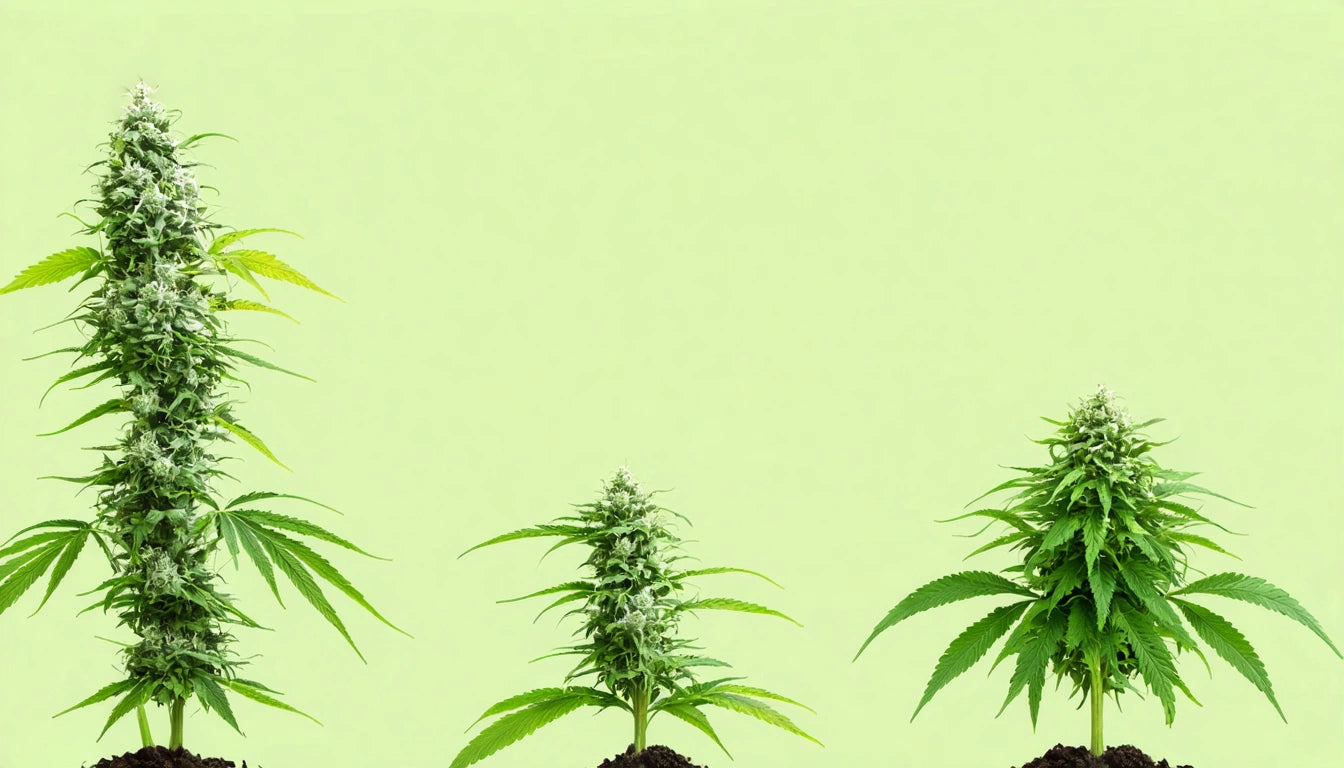Table of Contents
- Average Cannabis Plant Heights by Growing Environment
- Key Factors Affecting How Tall Cannabis Plants Grow
- Strain Differences in Cannabis Plant Height
- Techniques for Controlling Cannabis Plant Height
- Maximizing Yield Without Excessive Height
- Height Management Strategies for Different Cultivation Spaces
How Tall Do Weed Plants Get? Maximum Height and Growth Potential
Cannabis plants display remarkable variability in their growth potential, with heights ranging from compact 1-2 foot indoor specimens to towering outdoor plants that can reach over 20 feet under ideal conditions. Understanding how big weed plants can get is essential for cultivators planning grow spaces, selecting appropriate strains, and implementing effective training techniques.
Average Cannabis Plant Heights by Growing Environment
The environment in which cannabis is grown significantly impacts its ultimate height. According to research on cannabis growth potential, plants typically reach the following heights at maturity:
- Indoor grows: 2-4 feet (60-120 cm)
- Greenhouse cultivation: 4-8 feet (120-240 cm)
- Outdoor gardens: 6-15+ feet (180-450+ cm)
These figures represent averages, with significant variation based on genetics, growing techniques, and environmental conditions. Outdoor plants can grow substantially taller because they aren't constrained by ceiling heights and can develop more extensive root systems in natural soil.
Key Factors Affecting How Tall Cannabis Plants Grow
Genetics and Strain Selection
The genetic makeup of a cannabis plant is the primary determinant of its height potential. Indica-dominant strains typically grow shorter and bushier, while sativa-dominant varieties can reach impressive heights with longer internodal spacing. Autoflowering strains, which contain ruderalis genetics, generally remain compact regardless of environmental conditions.
Light Exposure and Photoperiod
Light plays a crucial role in determining how big weed plants get. During the vegetative stage, longer light exposure (18+ hours daily) promotes vertical growth. Once flowering begins, plants typically increase in height by 50-100% before focusing energy on bud production. Understanding pre-flowering height helps growers anticipate final dimensions.
Container Size and Root Development
Root restriction significantly limits cannabis growth potential. Plants in small containers (1-3 gallons) typically remain under 3 feet tall, while those in 10+ gallon containers or planted directly in the ground can achieve their maximum genetic height potential.
Strain Differences in Cannabis Plant Height
Different cannabis varieties have dramatically different growth patterns:
- Indica strains: Typically 2-4 feet tall, compact and bushy
- Sativa strains: Can reach 6-20+ feet tall with appropriate conditions
- Hybrid strains: Usually 3-10 feet tall, depending on dominant genetics
- Autoflowering varieties: Generally remain under 4 feet regardless of conditions
When planning a grow, selecting the right genetics is crucial for space management. As noted in this beginner's guide to growing cannabis, matching strain selection to your available space is a fundamental consideration.
Techniques for Controlling Cannabis Plant Height
Growers have developed numerous methods to manage how tall weed plants grow:
Training Methods
- Low-Stress Training (LST): Gently bending and securing branches horizontally
- Screen of Green (SCROG): Using a screen to create an even canopy
- High-Stress Training (HST): Techniques like topping, FIMing, and super cropping
These approaches not only control height but can increase yields by creating more bud sites and improving light penetration. Essential growing tips often emphasize these training methods for both indoor and outdoor cultivation.
Environmental Controls
Light spectrum also influences height, with blue-dominant light promoting shorter, bushier growth and red-dominant light encouraging stretching. Many growers use this knowledge to manage plant height, particularly during the early flowering stretch when plants can double in size.
When considering how big cannabis plants get, it's important to also consider potential yield per plant, as there isn't always a direct correlation between height and harvest weight.
Maximizing Yield Without Excessive Height
While cannabis plants can grow remarkably tall, excessive height doesn't necessarily translate to higher yields. In fact, many commercial growers intentionally keep plants shorter to create dense, efficient canopies that maximize light utilization and simplify maintenance.
For home growers concerned about space limitations, proper safety considerations should be implemented regardless of plant size, especially in households with children where secure growing areas and appropriate storage containers are essential.
Techniques like Sea of Green (SOG) demonstrate that multiple smaller plants can often produce more total yield than fewer large plants in the same space. This approach is particularly valuable for indoor growers with height restrictions.
Height Management Strategies for Different Cultivation Spaces
Successful cannabis cultivation requires adapting height management to your specific growing environment:
Indoor Growing
With typical ceiling heights of 8-10 feet, indoor growers must carefully manage plant height. Recommended approaches include:
- Early training to establish horizontal growth patterns
- Shorter vegetative periods (2-4 weeks) before flowering
- Selecting naturally compact strains
- Using techniques like topping to create multiple main colas
Outdoor Growing
While outdoor plants can grow extremely tall, there are still reasons to control height:
- Maintaining discretion in legal growing areas
- Preventing wind damage to tall, top-heavy plants
- Facilitating easier harvesting and maintenance
- Creating wider, bushier plants that maximize sun exposure
Understanding natural growing conditions can help outdoor growers better anticipate and manage plant height based on their local climate and growing season length.
For both indoor and outdoor cultivation, the question of how tall weed plants get ultimately depends on a complex interplay of genetics, environment, and grower intervention. By understanding these factors and implementing appropriate techniques, cultivators can effectively manage cannabis height to suit their specific needs and growing conditions.











Leave a comment
All comments are moderated before being published.
This site is protected by hCaptcha and the hCaptcha Privacy Policy and Terms of Service apply.